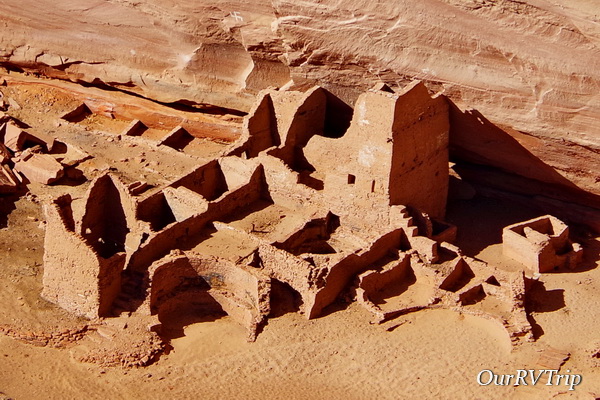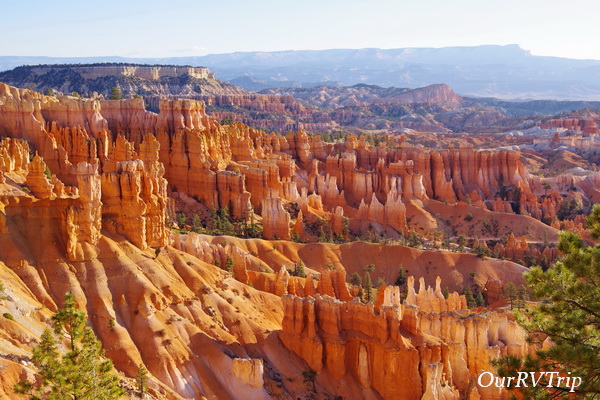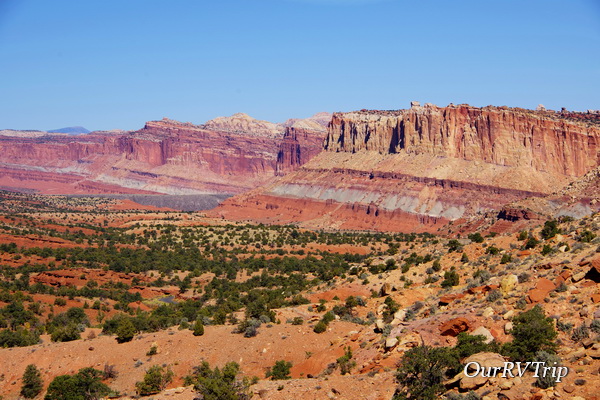
Ancient Dwellings
Hey Guys!! We’re in Arizona!! Utah was so much better than I thought it would be. I mean, I knew it was going to be amazing…I’d seen all of the pictures of the various National Park Units throughout the state, but Guys, the whole two months we spent exploring Utah were way better than we’d expected.
Utah was harder than we expected too. The remoteness of it…the lack of good groceries stores…not even a Walmart in most areas that we stayed. It was really great to pull into Page and see some major chain stores! Ha!! It’s all about the little things…like being able to find the right brand of cat litter or the right dish soap.
The RV park we stayed at had these really cool covered wagons that you can book and stay in! So neat! I kept seeing people walk up to the wagons and try to get into them. I guess out of curiosity, but sheesh…can you imagine staying in one and having a constant stream of people trying your door handle? We’ll actually be back in this park on our way North after the winter passes and I think I’m going to ask someone in the office if I can see the inside of one! I’m super curious.
We stayed in the Page area so we could explore a few different National Park Units. Canyon de Chelly National Monument was quite the drive from Page, but we were the closest we would be and we all really wanted to see this park. We found out about this park back in 2015 while we were exploring Wupatki National Monument. The Ranger there told us about Canyon de Chelly and we immediately stuck it on our need-to-see list.
Canyon de Chelly National Monument is actually still home to several Navajo families. They live down in the canyon during the summer months then move up to the rim community during the winter months. I worried it would be super awkward driving around their community to the various viewpoints, but it wasn’t. Not really. Everyone we met was welcoming and had stories of their life in the canyon to tell along with some beautiful handmade jewelry or pottery to sell. If you make it to Canyon de Chelly…and I highly recommend it…make sure to take cash because you’ll want to take home some of their wonderful wares. We ended up with several things. We bought some jewelry as well as the items pictured. Everything was fairly priced. Everything was expertly made. And everything came with the opportunity to get to know one of the residents.
One thing I didn’t know before we visited Canyon de Chelly is that the National Monument is actually split up into two different canyons. Canyon del Muerto (North Rim) and Canyon de Chelly (South Rim). You drive down one then turn around and drive the other. I honestly didn’t think this park would take long. We had no plans of taking a tour down in the canyon…so I figured a couple of hours and that would be it. I didn’t plan on two different canyons with a very low speed limit! But, its all a residential area, so the speed limit makes total sense.
North Rim Drive is 34 miles round trip and has several stops along Canyon del Muerto. The maze of canyons known as Canyon de Chelly has been occupied for close to 5,000 years and has encompassed many different cultures. The current residents, the Navajos, have made this canyon their home since the 1700s.
The canyon walls go from around thirty feet at the canyon entrance to a soaring 1,000 feet in some places. At each viewpoint along the rim drive you can see evidence of both past and present residents. Right by the ancient dwelling (the Navajo don’t like to call them ruins because they don’t see them as ruins), you’ll find a freshly plowed field waiting for the seasonal planting.
When you visit Canyon de Chelly National Monument, make sure you bring some binoculars…you’ll need them. We appreciated these view finders we found at almost every spot. When you’re trying to find something all the way across the canyon…it can be hard to pinpoint exactly where you’re supposed to be looking. The view finders they have up are super helpful. We would locate the ancient dwelling with the view finder then use our binoculars to get a better look at it.
Established in 1931, Canyon de Chelly National Monument preserves and protects nearly 5,000 years of human history within the 84,000 acres that make up the park. When you visit any National Park you should be respectful of what the park is trying to preserve, but I feel like at parks like Canyon de Chelly, you should be extra careful…extra respectful. You’re essentially visiting someone’s home and when you’re a guest in someone’s home you try to learn, respect and observe their customs and beliefs.
We also made a trip to Navajo National Monument. This NPS unit protects three ancient Ancestral Puebloan dwellings built into the cliff walls of the Tsegi Canyon System. Tsegi is pronounced SAY-ih and means a spiritual and physical home.
Navajo National Monument is a smaller park with only around 360 acres. There’s a great little museum and gift shop at the visitor center. We learned so much about the Navajo culture from this park and Canyon de Chelly. The structure in the picture above is an old style hogan. A hogan is the traditional home of the Navajo people. The word hogan comes from the Navajo word hooghan (ho-won). Everything about the construction and the elements of the hogan have meaning and purpose. Everything. Even the direction you walk when you enter a hogan. The hogan is round because the Navajo (they call themselves Diné) have always believed that the world is round and that everything in our world is connected within a circle.
Navajo National Monument protects three puebloan dwellings. You can only see one of them from the trails. The Sandal Trail is only about a mile long (round trip) and it takes you down to an overlook for the Betatakin dwelling. You can also take a guided tour to see this dwelling. We would have loved to do that, but we were there in the wrong season. The Betatakin dwelling was used for about fifty years before it was abandoned. They think there were close to 100 people living here while it was occupied. The cliff dwellings are so often built in an alcove because that is a source of water. The alcoves are made from water seeping through the sandstone and they would collect the water to use while they lived there.
The Keet Seel dwelling can be seen through a guided 17 mile round-trip tour. That’s a long hike, but it’s to see one of the best preserved dwellings in the Southwest. Keet Seel is the biggest of the three dwellings protected in Navajo National Monument and was occupied much longer than Betatakin. The Inscription House is currently closed to the public because it’s unstable and not safe for people to explore.
The boys got some pretty cool swag at Navajo National Monument for completing the Junior Ranger program! We really enjoyed chatting with the Rangers there! The Ranger in the photo wanted to get her picture taken with the boys because she hadn’t seen that many Junior Ranger Badges before. It’s always fun to watch the Rangers check out all the different badges Alex and Nicholas have earned.
Let’s talk foodies! We were pleasantly surprised with the foodies in Page! Not only did we find some really good Texas BBQ…I found my absolute favorite chili rellenos! We also found prickly pear tea. We’re huge fans of anything prickly pear so we were pretty stoked to find a tea made of it!
We had a busy two weeks in the Page area. I’m going to pause here on our Page area adventures. I’ve got more adventures, more National Park Units, and more foodies to tell you about next time!
See y’all down the road!
#NationalParkTour
































































